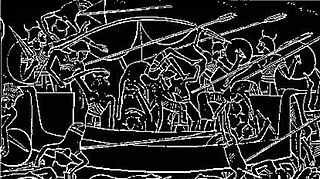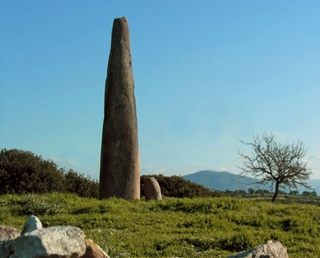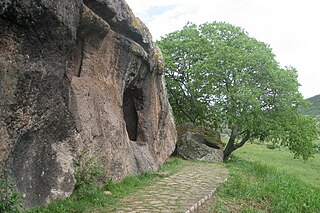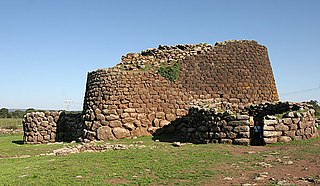
Archaeological evidence of prehistoric human settlement on the island of Sardinia is present in the form of nuraghes and others prehistoric monuments, which dot the land. The recorded history of Sardinia begins with its contacts with the various people who sought to dominate western Mediterranean trade in Classical Antiquity: Phoenicians, Punics and Romans. Initially under the political and economic alliance with the Phoenician cities, it was partly conquered by Carthage in the late 6th century BC and then entirely by Rome after the First Punic War. The island was included for centuries in the Roman province of Corsica et Sardinia, included in 3rd and 4th centuries in the Italia suburbicaria diocese.

The Sherden are one of several groups of Sea Peoples who appear in fragmentary historical and iconographic records, from the eastern Mediterranean in the late second millennium BC.

Giants' tomb is the name given by local people and archaeologists to a type of Sardinian megalithic gallery grave built during the Bronze Age by the Nuragic civilization. They were collective tombs and can be found throughout Sardinia, with 800 being discovered there.
Sardinia is probably the most culturally distinct of all the regions in Italy and, musically, is best known for the tenore polyphonic singing, sacred chants called gosos, the launeddas, an ancient instrument that consists of a set of three single-reed pipes, all three mouth-blown simultaneously using circular breathing, with two chanters and one drone and the cantu a chiterra, a monodic song that is accompanied by guitar, widespread mainly in the center and north of the island.

Su Nuraxi is a nuragic archaeological site in Barumini, Sardinia, Italy. Su Nuraxi simply means "The Nuraghe" in Campidanese, the southern variant of the Sardinian language.

The Nuragic civilization, also known as the Nuragic culture was a civilization or culture on the island of Sardinia, the second largest island in the Mediterranean Sea, which lasted from the 18th century BCE to 238 BCE when the Romans colonized the island. Others date the culture as lasting at least until the 2nd century CE or possibly even to the 6th century CE.

The Torrean civilization was a Bronze Age megalithic civilization that developed in Southern Corsica, mostly concentrated south of Ajaccio, during the second half of the second millennium BC.

The Sardinians, or also the Sards, are the native people and ethnic group from which Sardinia, a western Mediterranean island and autonomous region of Italy, derives its name.

The Ozieri culture was a prehistoric pre-Nuragic culture that occupied Sardinia from c. 3200 to 2800 BC. The Ozieri was the culmination of the island's Neolithic culture, and takes its name from the locality where early findings connected with it have been found, the cave of San Michele near Ozieri, in northern Sardinia. The Ozieri existed contemporaneously with the Arzachena culture, sharing some similarities, and its influence also extended to nearby Corsica.

The Giants of Mont'e Prama are ancient stone sculptures created by the Nuragic civilization of Sardinia, Italy. Fragmented into numerous pieces, they were found by accident in March 1974, in farmland near Mont'e Prama, in the comune of Cabras, province of Oristano, in central-western Sardinia. The statues are carved in local sandstone and their height varies between 2 and 2.5 meters.

The Pre-Nuragic period refers to the prehistory of Sardinia from the Paleolithic till the middle Bronze age, when the Nuragic civilization flourished on the island.

The Nuraghe Arrubiu is one of the largest of the nuraghi in Sardinia. It is located in Orroli, in province of South Sardinia. Its name means "red Nuraghe" in the Sardinian language, which derives from the basalt stones of which is built.

Castelluccio culture is an archaeological feature dating to Ancient Bronze Age of the prehistoric civilization of Sicily, originally identified by Paolo Orsi on the basis of a particular ceramic style, in the homonymous village, between Noto and Siracusa.

The nuragic holy well is a typical Sardinian hypogean Bronze Age structure for the worship of the waters. Scattered throughout the island, along with the Giants' grave and the megaron temples, they testify to the deep religiosity of the Nuragic populations. These temples were a place of pilgrimage and ceremonies: it is believed that at certain times of year the various nuragic populations of the area gathered together in their vicinity.

The necropolis of Sant'Andrea Priu is an archaeological site located on the south side of the fertile plain of Saint Lucia, in the municipality of Bonorva, Sardinia. The complex, one of the most important of the island, is composed of twenty domus de janas; one of them with its eighteen rooms appears to be one of the largest hypogean tombs of the Mediterranean basin.

Hampsicora was a Sardo-Punic political leader and landowner of Sardinia, and the leader of the major anti-Roman revolt in the province of 215 BC.

The Giants' grave of Su Mont'e s'Abe is an archaeological site located in the municipality of Olbia, in the Italian province of Sassari.

Nuraghe Su Mulinu is an archaeological site located in the territory of Villanovafranca, in the province of South Sardinia.






















